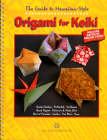
The Guide to Hawaiian-Style
Origami for Keiki
By Jody H. FukumotoSeventh Printing 2004, 36 pages, Paperback
Includes origami paper.

 |
The Guide to Hawaiian-Style
By Jody H. Fukumoto |
ORDER -- Item #3304, Price $8.99
Book Description from the Back Cover
Back to the Top
As you may know, in origami, there are standard one-step instructions that actually require several steps to accomplish. I have either avoided these instructions or have included all the steps, showing the folder exactly what to do. Origami shortcuts are taken primarily in the initial instructions of a model. These instructions, which consist of folding a sheet of paper in half, are covered in the "how to" section, Folding Lessons. In Folding Lessons, children learn important arrows and lines as they are applied. They learn methods that teach them not only how to fold, but how to fold precisely.
Origami does require eye/hand coordination. At what age a child can physically execute the folds depends upon the individual. The ability to read is very helpful but not totally necessary. Very young children can fold by looking at the diagrams if they are shown the basics and guided through the instructions. If a child shows the desire to fold origami but has not developed the coordination for it, an option is to pre-fold the models and let her refold them.
You will find that origami is a great teacher. It teaches a child how to follow instructions and how, by following a process, a result is achieved. Origami also teaches patience and that it takes time to do things correctly. It teaches geometry and to see things spatially. In origami, a child learns to read diagrams, correlating the two-dimensional drawings to the three-dimensional model he is creating. Thus, when folding, a child reasons and visualizes.
I hope that this book will help develop your child's interest in origami. A hobby, after all, is an interest in life.
A Note From the Author
When I demonstrated my "Hawaiian-style" origami at the Bishop Museum in Honolulu, school groups would gather at my table and would have to be ushered away by their teachers to other exhibits. 1 discovered then that children were fascinated with origami. To fuel that fascination, I have created imaginative and playful models. In efforts to keep that fascination from turning into frustration, I have developed kid-friendly instructions. With the help of Island Heritage, I have also designed special paper, included with this book, allowing children to create the exact models seen in the book. The included paper also depicts instructional lines to help them with certain folds. An extra sheet of each design is supplied mainly because children like to repeat things that they are successful at. And this book is written and diagrammed to help children succeed in folding.
About |
Contact |
New |
Specials |
Browsing |
Ordering |
Conference |
Links |
Help
Copyright © 2005 by AACP, Inc.
Most recent revision June 16, 2005